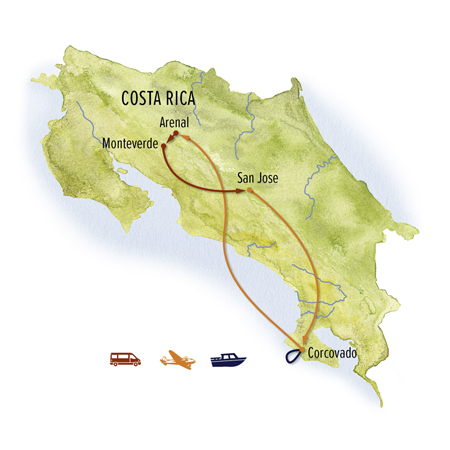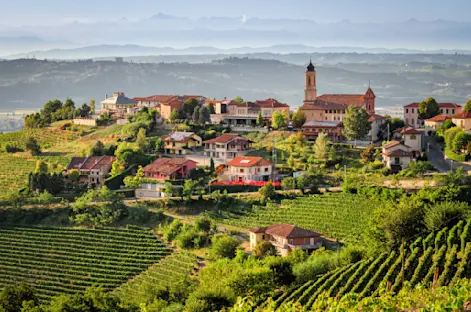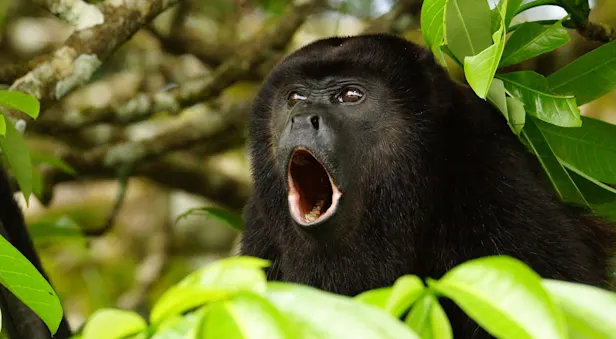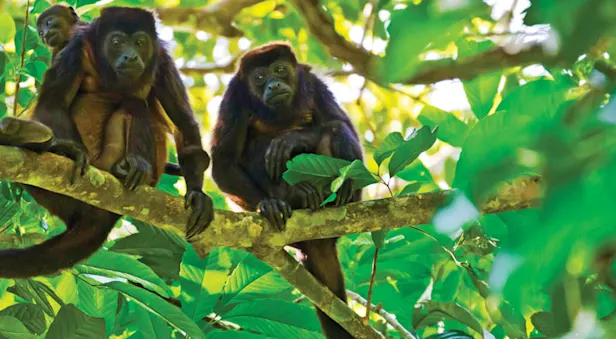
Our Costa Rica adventure tour begins in the capital of San Jose, where you’re met at the airport and transferred to our luxurious hacienda-style hotel surrounded by lush gardens and nature trails. This evening, gather for a welcome dinner with our Expedition Leader.
Our destination today is the remote Osa Peninsula at the southern end of Costa Rica's Pacific coast. Just getting there is an adventure, as we fly direct via private chartered plane to the peninsula and board 4x4 vehicles to reach the village of Agujitas on Drake Bay. Here, we board a boat and make a wet landing on the beach, then ride tractors up the hill to reach our accommodation for the next three nights, a luxury ecolodge on the edge of Corcovado National Park, the crown jewel of Costa Rica’s national park system. Corcovado Wilderness Lodge, surrounded by a 170-acre private reserve, offers convenient access to Corcovado National Park, which National Geographic has described as the “most biologically intense place on Earth.” Here among Costa Rica’s largest trees, we find Central America’s densest populations of scarlet macaws, tapir and the highly elusive jaguar. After lunch, walk the Sendero Azul, a short private trail on the lodge reserve. Woody vines, towering trees and walking palms line the way as we search for sloths, monkeys, agoutis, coatis and intriguing birdlife, including Baird’s trogon, spectacled owl and black-cheeked ant tanager.
Discover more of Corcovado's treasures on extended nature walks. As our long journey to reach this place attests, the Osa Peninsula is a wild and remote locale. It supports one of the world's most diverse lowland rainforests and is considered Costa Rica’s last wilderness frontier. Corcovado National Park, which covers 100,000 acres and one-third of the peninsula, includes at least 13 different ecosystems and protects a multitude of endemic wildlife and plant species. This biological diversity stronghold contains half of Costa Rica’s animal species, including scarlet macaw, toucans, parrots, all four monkey species found throughout the country, and jaguar, although these shy cats are rarely seen. With rich interpretation from our Expedition Leader, look for and learn about the many fascinating creatures that reside in Corcovado's ancient forests.
Fly by chartered plane today to Arenal and transfer to Arenal Nature Reserve. With our Expedition Leader, explore the dense rainforest on morning and afternoon walks on the vast network of trails radiating from Arenal Observatory Lodge. The grounds, laced with rivers and waterfalls, include nearly 700 acres of primary rainforest and tropical gardens—one of the largest natural reserves in Costa Rica. Among the lush vegetation and colorful flowers, we find both resident and migratory tropical birds, including a multitude of hummingbirds, and lively monkeys, including howler, spider and white-faced capuchin species. Other mammals are more rarely seen, but we might glimpse peccary, coati, margay or ocelot, plus sleepy sloths high in the branches. Our easy hikes include a walk to Danta Waterfall, a rushing cascade that tumbles 20 feet off a shaded precipice into a clear tropical pool below. Two hanging bridges give an eye-level perspective on the canopy and offer grand views of Arenal Volcano.
The morning is at leisure to relax among the gardens around our lodge, wander nature trails on your own, or check out the Observatory Visitor Center where exhibits offer insight into the natural history of the Arenal region, the dam creating Lake Arenal, and volcanology research in the region. Among those conducting environmental studies here since the early 1970s have been volcanologists, botanists, biologists and geologists from the Smithsonian Institution, Earthwatch Institute, Costa Rica Observatory of Volcanology and Seismology, and the University of California.
We then depart for lunch, followed by a guided rainforest walk on the private Mariolas Trail in search of sloths and birds. Exploring our lush environs, keep your gaze upward to spot both two- and three-toed sloths at home here. Three-toed sloths are more likely to be spotted awake during the daylight hours, hanging languidly from the tree branches as they slowly chew on leaves. We commonly see baby and adolescent sloths clinging to their mothers high in the canopy. Meanwhile, nocturnal two-toed sloths spend their afternoons peacefully snoozing in the treetops. A variety of birds is on display, too—look for the bright flash of feathers revealing a showy scarlet macaw or the brilliant beak of a toucan.
Next, enjoy a private tour revealing how coffee and chocolate—two famous Costa Rican exports—are made. Our hosts on this small farm that grows both coffee and cacao offer an up-close overview of the process, with a chance to sample the finished products at the end. On trails through the orchard and at demonstration sites, learn how the plants are cultivated, how beans are harvested, dried and roasted, then turned into a cup of coffee or a chocolate bar. During our tour, we’ll gain insight into the special importance of coffee to Costa Rica’s economy and culture. Afterward, we head into the town of La Fortuna for some free time before dinner at a local restaurant.
Depart Arenal this morning on a scenic drive into the higher-elevation cloud forest, winding up twisting roads from the lowlands into the cool heights of Monteverde, which means “green mountain." Moisture here doesn’t typically come from rain but rather from the constant mists that swathe the mountaintops, creating the cloud forest environment. Straddling the spine of Costa Rica’s continental divide, Monteverde Cloud Forest Reserve supports 2.5% of worldwide biodiversity, including 100 mammal species and 161 different amphibians and reptiles. Many of these are indicator species, which means they are sensitive to environmental changes and can alert us when an ecosystem is threatened. Some of these unique creatures are found only in the high mountains of Costa Rica and neighboring Panama.
Our secluded ecolodge offers the ideal base for exploring, surrounded by lush gardens, dense forest and the melodious calls of birds in the canopy—more than 400 species flourish here, including the rare three-wattled bellbird. Just four populations of this Central American endemic remain, one of which is found in this area. Our Expedition Leader gives a talk on conservation, restoration and reforestation of the Pacific slope habitats of this bird known for its distinctive chiming call. Other highland endemics include the umbrella bird, emerald toucanets, and the resplendent quetzal, the iridescent bird sacred to the Indigenous people of these remote mountains.
Monteverde is the most studied montane cloud forest environment in the world, and one of the world's most threatened ecosystems. Nurtured by perpetual mists, it harbors an estimated 3,200 species of plants including giant strangler figs, a profusion of epiphytes that drape the forest from canopy to floor, and 500 different orchid species. As we explore the forest, look for wild relatives of many familiar houseplants such as philodendrons, bromeliads, ficus and ferns, and spot colorful butterflies flitting among the leaves.
We get a different view of the intricate web of life on display via the Skywalk, a 1.5-mile network of elevated walkways that lift us into the canopy. About 90% of all organisms in the cloud forest live in the treetops, which the sun strikes to produce abundant food. Later this afternoon, explore the Curi-Cancha Reserve, a private sanctuary frequented by a great variety of birds, including the resplendent quetzal and bellbird. Curi-Cancha is 50% virgin forest, with most of the remainder restored to native forest from pastureland in recent decades. Mammal sightings may include agouti, coati, armadillo, kinkajou, ocelot, sloth, olingo, porcupine and three species of monkey: mantled howler, white-faced capuchin and spider monkey. Sometimes, if we are more likely to see quetzals in the nearby Monteverde Cloud Forest Reserve, we may substitute a visit here in lieu of Curi-Cancha, with similar wildlife sightings possible.
After breakfast, we return by road to the San Jose airport to connect with homeward flights. Please schedule flight departures any time after 12:30 pm today.




































